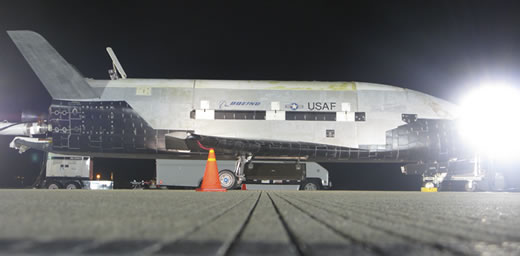
After spending 220 days in space the U.S. Air Force’s X-37B unmanned re-entry spacecraft landed at Vandenberg Air Force Base just after midnight (1:16am pacific time) December 3, 2010. X-37B designated the ‘First Orbital Test Vehicle’ (OTV-1), was built by Boeing [NYSE: BA] to experiment rapid deployment of space assets under the Air Force’s Rapid Capabilities Office (AFRCO). The X-37B program is demonstrating a reliable, reusable unmanned space test platform for the Air Force, providing developmental risk reduction for such program. The unmanned spacecraft was launched from Cape Canaveral Air Force Station, in Florida on April 22.

A view taken by a FLIR Systems thermal camera, recording the landing of the unmanned X-37B space plan.

The X-37B is the United States’ first unmanned vehicle to return from space and land on its own. Previously, the manned space shuttle was the only space vehicle capable of returning to Earth. Russia has already tested a similar unmanned concept with the Buran unmanned space shuttle 22 years ago but did not pursue this direction further than proof of concept.
The success of this inaugural mission demonstrates that unmanned space vehicles can be sent into orbit and safely recovered. “This marks a new era in space exploration, and we look forward to the launch of the second vehicle in 2011.” said Paul Rusnock, Boeing vice president of Experimental Systems and program director for the X-37B. Boeing’s experience in space-based unmanned vehicle spans a decade and includes support to the Air Force Research Lab’s X-40 program, NASA’s X-37 program, and the Defense Advanced Research Projects Agency’s X-37 Approach & Landing Test Vehicle (ALTV) program.
What was the X-37B doing during the eight months mission in space? The Air Force is not releasing information about the current or future mission, but, according to DODBuz, it is clear the spacecraft has a spacious payload bay that can accommodate small satellites, or other payloads that could be retrieved after a short mission. Amateur spacecraft trackers following the mission of the spacecraft have indicated it performed at least four maneuvers while in space, demonstrating its ability to position a small reconnaissance or communications satellite in low earth orbit, responding to theater intelligence requirements in support of Combatant commanders.
Read more: http://www.dodbuzz.com/2010/12/03/what-could-x-37b-do/#ixzz175MUY0Jz



















